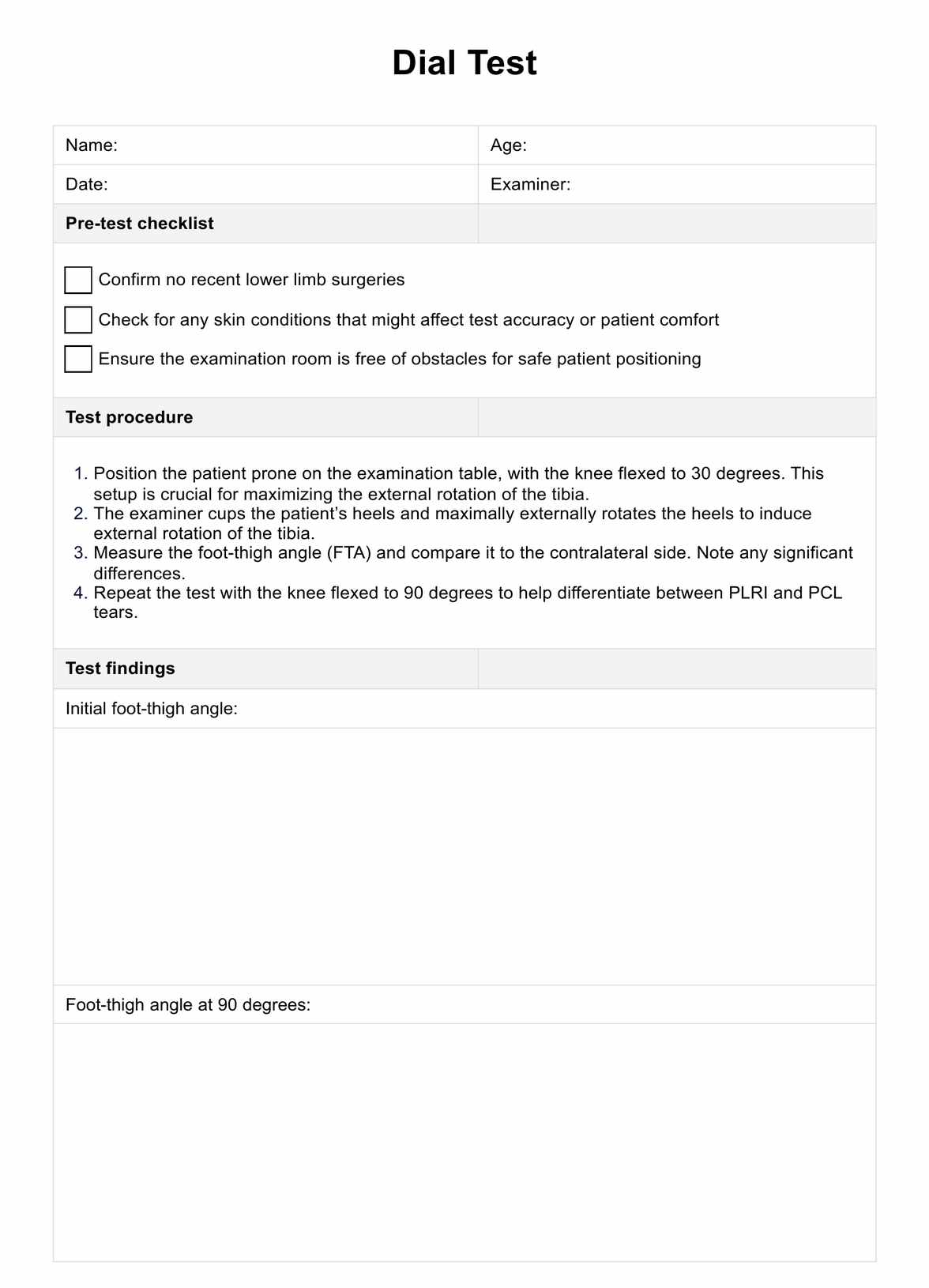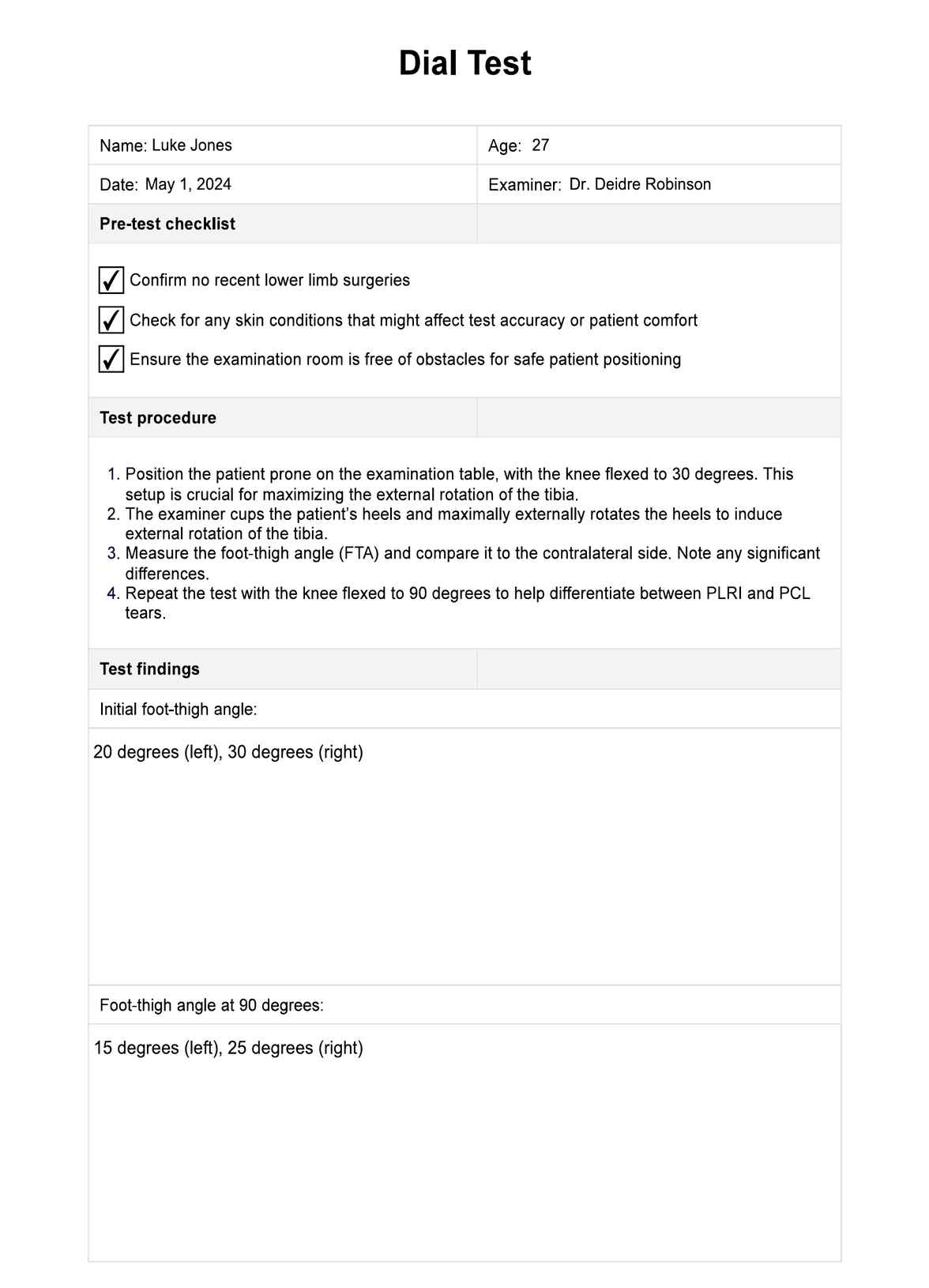Dial Test
Explore the Dial Test template from Carepatron to accurately assess and document knee instability, enhancing diagnostic precision in clinical settings.


What is posterolateral knee instability?
Posterolateral knee instability (PLKI) is a condition characterized by laxity or looseness in the posterolateral corner (PLC) of the knee, which can lead to significant stability issues and discomfort. This instability affects the outer aspect of the knee, where the tibia (shinbone) meets the femur (thighbone), compromising the knee's ability to withstand rotational forces.
Symptoms of posterolateral knee instability often include pain and swelling on the outside of the knee, a feeling of the knee giving way during activity, and difficulty with twisting or turning movements. Patients may also report a sensation of the knee locking or catching, particularly when attempting to change direction quickly.
Causes of posterolateral knee instability
Posterolateral knee instability often results from traumatic injuries, typically seen in sports or severe accidents, where the knee experiences direct blows or undergoes sudden, forceful twists, potentially damaging the anterior cruciate ligament and other critical structures for lateral knee stability.
Injuries to the lateral ligament compartment, including the lateral collateral ligament, the popliteofibular ligament, and the posterolateral corner injury, are common sources of instability. These structures are vital for preventing excessive lateral opening and rotational instability of the knee. Isolated fibular collateral ligament injuries, although less common, also significantly contribute to overall instability.
Combined posterolateral knee injuries pose a particular challenge as they affect multiple stabilizing components simultaneously, often requiring comprehensive approaches including posterior cruciate ligament reconstruction to restore stability and function adequately. These complex injuries require a thorough understanding of knee mechanics and often involve multiple surgical interventions to adequately restore stability and function.
How to diagnose a posterolateral knee instability or injury?
Diagnosing PLKI often starts with a detailed medical history and physical examination, focusing on any incidents that could have led to knee injuries. Key diagnostic tools include:
- Physical tests: Specific maneuvers, like the Dial Test, assess the integrity of the PLC.
- Imaging: MRI scans are particularly useful for visualizing the extent of soft tissue damage, while X-rays help to rule out bone fractures.
- Stress radiography: This can be used to assess the degree of knee laxity more precisely.
Proper diagnosis is crucial as it guides the subsequent treatment and rehabilitation processes, ensuring the best possible recovery and return to function for the patient.
Dial Test Template
Dial Test Example
What is the Dial Test?
The Dial Test is a clinical assessment used to evaluate posterolateral rotatory instability (PLRI) of the knee. This test is particularly valuable in detecting injuries to the posterolateral corner of the knee, which can affect the stability and functionality of the joint. The test primarily measures the amount of external rotation of the tibia relative to the femur and is crucial for diagnosing the integrity of structures such as the lateral collateral ligament, the popliteofibular complex, and the posterior cruciate ligament.
The purpose of the Dial Test is to identify discrepancies in tibial rotation between the injured and non-injured legs which can indicate the presence of PLRI. This test is often used in conjunction with other diagnostic tools to provide a comprehensive evaluation of knee stability.
How to conduct the Dial Test?
Conducting the Dial Test involves a series of steps designed to assess the degree of external tibial rotation, which can indicate the integrity of the PLC:
- Position the patient prone on the examination table, with the knee flexed to 30 degrees. This setup is crucial for maximizing the external rotation of the tibia.
- The examiner cups the patient’s heels and maximally externally rotates the heels to induce external rotation of the tibia.
- Measure the foot-thigh angle (FTA) and compare it to the contralateral side. Note any significant differences.
- Repeat the test with the knee flexed to 90 degrees to help differentiate between PLRI and PCL tears.
Each step is crucial for ensuring the accuracy of the test and should be performed with careful attention to the patient's response and any signs of discomfort.
What are the limitations of the dial test?
While the Dial Test is a valuable diagnostic tool for assessing posterolateral knee instability, it has several limitations that clinicians should consider:
- Specificity to PLRI: The Dial Test is specifically designed to identify posterolateral rotatory instability. It does not provide information about other knee pathologies or injuries to structures not involved in PLRI, such as the anterior or medial aspects of the knee. This specificity means that additional tests and imaging are often necessary to obtain a complete diagnostic picture.
- Interpretation variability: The results can vary based on the examiner's technique and experience. The exact degree of external rotation and the subjective nature of what constitutes significant differences in rotation between sides can lead to variability in outcomes.
- False positives/negatives: Conditions like hamstring tightness or previous knee injuries can affect the outcomes, leading to potential misinterpretations. These conditions may mimic or mask the symptoms of PLRI, resulting in false positives or negatives.
- Sensitivity issues: The test may not be as sensitive in cases with multiple ligament injuries, including combined injuries involving the posterior cruciate ligament. This can affect the test's reliability in accurately diagnosing the extent of the injury.
Given these limitations, the Dial Test should be used as part of a broader assessment strategy, incorporating other clinical tests and imaging studies to diagnose knee injuries accurately.
How does our Dial Test template work?
Our Dial Test template is meticulously designed to support health professionals in conducting and documenting the Dial Test effectively. This template facilitates the systematic evaluation of posterolateral knee instability, ensuring that all necessary information is captured for accurate diagnosis and treatment planning.
Step 1: Access this template
Healthcare professionals can easily access the Dial Test template through the Carepatron platform. It is available for both digital use and printing, making it versatile for various clinical settings, whether in-office or during field assessments.
Step 2: Explain the template
Before starting the test, it's crucial for practitioners to explain the purpose and structure of the template to the patient or assisting healthcare staff. This includes discussing the preparation checklist, procedural steps, and how findings will be recorded. Ensuring everyone understands the process helps in obtaining accurate results and enhances patient cooperation.
Step 3: Prepare for the test
Utilize the preparation checklist included in the template to make sure all necessary conditions are met before beginning the test. This includes confirming the absence of recent lower limb surgeries, checking for skin conditions, and ensuring the examination room is appropriately set up for safe test administration.
Step 4: Conduct the test
Follow the detailed steps outlined in the template to perform the Dial Test. This includes positioning the patient, externally rotating the heels, measuring the foot-thigh angle, and repeating the test at different knee flexion degrees to assess for PLRI and potentially PCL injuries.
Step 5: Document the findings
Record the test findings in the designated sections of the template. Note the angles measured, any significant differences observed, and other relevant clinical observations. This information is crucial for determining the next steps in the patient's care plan.
By using our Dial Test template, healthcare professionals can ensure a standardized approach to diagnosing posterolateral knee instability, improving the accuracy and reliability of the test results. This template not only aids in the assessment process but also enhances documentation and follow-up care.
Benefits of using our template
Our Dial Test template offers several significant advantages for healthcare professionals dealing with knee injuries, particularly posterolateral knee instability. Here are some key benefits of using this template:
- Standardized testing procedure: The template ensures that the Dial Test is performed consistently and correctly across different settings. By standardizing the test procedure, it minimizes variability in results due to examiner differences, thus enhancing the reliability of the diagnosis.
- Enhanced documentation: With designated fields to record each step of the test and its findings, the template simplifies documentation. This detailed record-keeping is invaluable for tracking patient progress over time, sharing information with other healthcare providers, and maintaining comprehensive patient records.
- Improved patient education: The template serves as an educational tool, helping patients understand the purpose and process of the Dial Test. This transparency can alleviate patient anxiety about the procedure and encourage their cooperation, leading to more accurate test outcomes.
- Facilitates training: The template is an excellent resource for training new staff members. It provides a clear framework for teaching the procedural steps and interpreting the results, ensuring that all practitioners have the necessary skills to conduct the test effectively.
- Quick reference in clinical practice: Designed for ease of use, the template acts as a quick reference, allowing healthcare professionals to efficiently conduct the Dial Test without missing any critical steps. This can be especially useful in busy clinical environments where time and accuracy are paramount.
Utilizing our Dial Test template can significantly improve the assessment of posterolateral knee instability, providing benefits that extend from the examination room to the broader scope of patient management and care coordination.
Treatment for posterolateral corner injuries
Treating injuries to the posterolateral corner (PLC) of the knee requires a tailored approach due to the variability in severity and type of injury. Initially, conservative management might be suggested, involving physical therapy aimed at strengthening the knee, enhancing stability, and reducing inflammation. In cases where additional support is necessary, particularly during recovery, wearing a knee brace may help stabilize the joint and prevent further damage while the healing process unfolds.
For more severe or complex PLC injuries, knee surgery repair or reconstruction may be necessary to restore the anatomical integrity and functionality of the knee. The posterior cruciate ligament, often implicated in these injuries, may require reconstruction to restore knee function, as detailed in studies published in journals like J Bone Joint Surg. This type of surgery is crucial for severe posterior cruciate ligament injuries, which frequently occur alongside damages to other lateral knee structures.
Anatomical posterolateral knee reconstruction may be necessary when there is extensive damage involving multiple structures. This surgery aims to rebuild the complex anatomy of the knee's posterolateral corner, addressing issues such as posterolateral rotatory instability—a condition characterized by increased tibial external rotation relative to the femur.
Following any surgical intervention, a comprehensive rehabilitation program is essential. Such programs typically focus on gradually rebuilding strength, flexibility, and overall function through targeted physical therapy.
For optimal treatment outcomes, consulting with a healthcare professional is crucial. Specialists consider various factors, including the patient's overall health, activity level, and specific injury details, to devise the most appropriate treatment plan. This personalized approach ensures that patients receive the necessary care to facilitate effective recovery and return to their daily activities.
Commonly asked questions
The Dial Test is a clinical procedure used to assess posterolateral rotatory instability (PLRI) in the knee by measuring the external rotation of the tibia in comparison to the femur.
The mechanism of the Dial Test involves maximally externally rotating the tibia at two different knee flexion angles (30 and 90 degrees) to identify instability in the posterolateral corner of the knee.
A positive Dial Test indicates excessive rotational mobility, which may suggest posterolateral rotatory instability (PLRI) or damage to structures like the posterior cruciate ligament (PCL), depending on the angles at which abnormalities are observed.







































































































